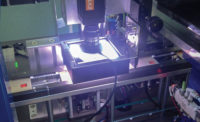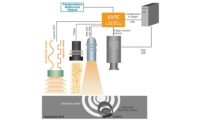
The real difference between smart cameras and vision sensors is based on the software that is built into the hardware. Source: EVT
In the past, most vision solution discussions started based on which hardware would have enough power to meet the requirements of the task. Within the last few years, the computational power in the small systems increased so fast that, for most applications, there are no restrictions in selecting one of the available platforms.
So how to decide between the different systems to create a vision solution? The question is not an easy one to answer. First of all, it is important to understand what a vision sensor, a smart camera or a PC-based solution is, and the difference in these systems. After all, it is even difficult for an expert to determine.
Target Use
First, divide the different systems based on their target usage, and then consider which is the best solution. The vision sensor, a newly founded product group, is determined by the hardware used, in general, a smart camera; most of these systems share the same central processing unit (CPU) with the same speed as a smart camera. So these systems are built to be a replacement for some light gages or related sensors. In recent years, it was even difficult to build somewhat powerful smart cameras, but today even the powerless CPUs are so fast that the systems based on these are powerful enough to create high-speed vision solutions.This is why the smart sensors and the smart cameras generally do not differ in the hardware, or if they do, the difference is very small. The real difference between smart cameras and vision sensors is based on the software that is built into the hardware.
So how to separate vision sensors and smart cameras? It is easy, and done by nearly all of the manufacturers-the vision sensors get only view functions so that the tasks that can be solved are restricted to the associated solution field, for example, a data matrix code (DMC) reader, distance measurement or color inspection. There is not only a restriction in the available instruction set, there also is an optimized user interface, so that any layman can use the sensors like they use normal sensors, such as a light gage.
The interesting thing is that it is easy to build special sensors based on this hardware. Because all of the information is available in the image, it is easy to build, as with a bottle cap sensor. If operators have to do the task with light gages, they need four of those and it is even difficult to adjust them so that the bottle cap could be inspected. The biggest improvement using a vision sensor is that the operator does not have to adjust a bunch of light gages, as with any other camera, it is only necessary to get the cap in the view of the sensor; simply set up the inspection areas on the screen and the vision sensor is ready for use.
Compared to a multisensor solution, it is easier to handle and adjust a new product or a modified sensor position.

In the past few years, the computational power in the small systems increased so fast that, for most applications, there are no restrictions in selecting one of the available platforms. Source: EVT
Smart Cameras Step Up
The next powerful step in machine vision is the smart camera. There are many types available with different processing power, so smart cameras can provide a solution for many applications. One might ask, “Why use a smart camera and not a PC-based solution?” As long as the processing speed is enough, the operator can choose the best one.However, there are some hard facts that will indeed point to the use of a smart camera. If it is a dirty environment where it is difficult to work with a fan for cooling, then a smart camera is the preferred solution. A smart camera has low power dissipation so the cooling can be done only with its housing. If a PC is used in this situation, it has to be built in a cabinet and, depending on the heat, there is additional cooling necessary. The average price of a cabinet is nearly close to the total price of the smart camera, so the total cost is much cheaper; and if an air conditioning system for the cabinet is necessary, the smart camera is much cheaper.
Smart cameras are more shock-resistant than PC systems with their hard disc and all the different components that are built in the housing, which might be damaged even if there are small shocks in the system, such as those generated from a stamping machine.
One of the biggest benefits of smart cameras is that they are not on the lifecycle of PC hardware; depending on the machine builder, the lifecycle of such a machine is 10 years. If you have a PC, even after one year it is difficult to build up the exact replacement for a damaged system. So there are additional tests necessary for the new system even if the same operating system (OS) is inside and the same software is running, only because it is not identical.
Smart cameras have an average lifecycle of 10 years-maybe more-so long term support for a smart camera-based product is much easier. The manufacturer can replace an old camera with the identical OS and the identical software that was used when the machine was delivered. This is the basis for an easy reproduction of a machine or a replacement if there was damage to the product. If nothing has to be changed, there are no uncertainties based on incompatibilities from the different hardware or OS.

The key is to develop software that runs on all platforms, with the same user interface; this is the basis for customers to select the best hardware for the task. Source: EVT
PC Power
Nevertheless, there also is a demand for PC systems. The problem with PC components changing rapidly is the biggest feature for new machine vision solutions. There are outstanding algorithms that are known, but could not be used due to a lack of computational power. This means the increase of CPU speed, which goes along with the nearly quarterly new developments, enables the vision industry to create solutions based on this speed improvement.The high-end inspection tasks such as surface inspection with a huge amount of data from high-speed line scan cameras requires nearly endless CPU power and memory. This is the domain for PC systems because it is easy to connect this type of camera by either of the different interfaces to the system. For multi-camera systems the GigE or FireWire interface will meet the need, and Camera Link will work for high-speed line scan cameras.
Based on the fast development, the next generation will give the operator the ability to solve unsolved tasks. For these types of applications, the PC is the right solution, particularly because the need for a cabinet or air conditioning does not apply-these systems are complex and thus not so cheap.
With different hardware platforms available, operators will find one to solve the needs of the task at hand. It is important that there is software that allows the operator to create the solution quickly and easily; it is difficult to be a master in different software systems. During development there must be one software that allows operators to create a solution for any of the described platforms. The biggest benefit of this is that the operator can select the proper hardware at any time and reuse the developed solution on the new hardware, with no or only a few minor modifications.
The key knowledge is to develop software that runs on all platforms, with the same user interface; this is the basis for customers to select the fitting hardware at any time and use the solution build on any of these. More importantly, the operator has to be trained only on one platform for all these solutions. V&S

